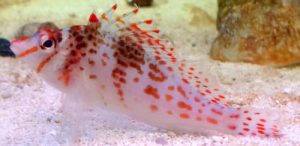
Cirrhitichthys falco
| Difficulty | Low |
| Minimum Tank Size | 30 Gallons |
| Diet | Carnivore |
| Water Parameters | 72-78 F, pH 8-8.4, Salinity 1.020-1.025 |
| Aggression | Semi-Aggressive |
| Size | 2.5" |
Falco Hawkfish are the smallest hawkfish available, coming in just under 3″. As with most hawkfish, the Falco Hawkfish can frequently be seen sitting on rocks, watching it’s tank mates as well as the aquarist. They are fairly easy to care for so long as you do not stock the tank incorrectly, such as many small prey fish or much larger predators.
Behavior
To understand the Falco Hawkfish’s personality, we need to understand its natural environment and the effect it has on light. Even in shallow waters the color red is quickly filtered out of the suns light. This means red fish are actually difficult to see under water. Due to the spotted stripe like appearance of the Falco Hawkfish, we can infer that the fish is typically well camouflaged. This, combined with their still position on rocks, makes them invisible hunters who can dart out and catch their food with ease.
With this personality in mind you can set up your tank to compliment this fish quite well. Provide the Falco Hawkfish with multiple hiding places, plenty of rock work and maybe even some macro algae to rest on. This will not encourage aggression but will keep the hawkfish far more comfortable than an open tank design.
While the Falco Hawkfish may be the smallest hawkfish, they can still be highly aggressive. This will mostly be seen with aquarists who keep small fish or add inverts after the hawkfish. Remember: All inverts that are intended to be kept with the hawkfish should be fairly large. Any small shrimp will be quick to disappear.
Diet & Feeding
The Falco Hawkfish will eat any frozen foods, marine meat or feeder shrimp you offer it. Likewise many will easily accept prepared foods, with flake being the most common food. This will not happen every time however, so be prepared for a picky eater hawkfish.
As the Falco Hawkfish will quickly spot the aquarist, they make for excellent feeding time announcers. Whenever I feed these hawks they quickly dash out, grab a mouth full of food and swim off to eat it. They will do this several times until they are full or can find no more food. during this action all the other fish should take notice and begin feeding along side him.
If you have a picky eater Falco Hawkfish I highly suggest starting your own feeder shrimp breeder tank. They aren’t too demanding and will quickly become a cheap source of natural food.
Aggression

Unlike some of their larger brethren, the Falco Hawkfish can be kept with a large variety of marine fish. The rules for tank mates are simple:
- Nothing can be significantly smaller than the hawkfish. Even young fish who will grow larger must only be added when they are at least as big as the falco.
- All Inverts must be added before the falco. New inverts will often be quickly attacked/seen as a feeding time
- If you will be housing multiple aggressive fish, choose a larger tank. In a 30 gallons you can expect to see a bit more aggression out of a falco.
- When in doubt, go without. The Falco Hawkfish does bring a lot of personality, however no one likes losing fish. If you are unsure whether or not your fish will get along, skip over adding a hawkfish.
If you choose to add anything after the hawkfish you can either add them at night or place a divider in the tank. This will give your fish or invert some extra safe time to get familiar with the tank before the hawkfish can start harassing them.
Sexing & Breeding
Falco Hawkfish are protogynous hermaphrodites, meaning that they can change from either gender to the other.
In the wild Falco Hawkfish will travel in schools, holding several females and one male. The male will be the largest, most dominant hawkfish in the group. Should there be too many females for the one male hawkfish another female will change genders into a male. This new male will take a portion of the females, creating a second group of hawkfish.
In the home aquarium you will typically only have two hawkfish. To ensure they pair successfully you will want one hawkfish to be well established and significantly larger than the new hawkfish. This will ensure the existing hawkfish becomes the dominant male. Putting two similar sized Falco Hawkfish in the same tank is likely to start a fight. While this may end with the loser being female, it is also likely that the loser will simply be bullied to death.
Hawkfish are pelagic spawners, meaning they rise to the top of the tank before releasing the genetic materials needed. This will produce plenty of tiny eggs, which are very difficult to see without any sort of magnification.
To incubate these eggs in a separate tank you will need a container to remove them form the original tank. I highly suggest a container that can hold water rather than a net. Nets will work well to catch the eggs but can easily harm the eggs, dramatically lowering the spawn rate of the Falco hawkfish.
Breeding will often take place just before or after lights out. This works best when the lighting system is automatic. If you are tying to breed the fish without a light timer, you will need to turn the lights off at the same time each day until the fish recognize the time.
Remember the Falco Hawkfish is a much smaller hawk and is easily bullied by larger predators. This will prevent any sort of breeding and sometimes even the initial pairing. If you intend on breeding ensure the hawks will live in a stress free environment.